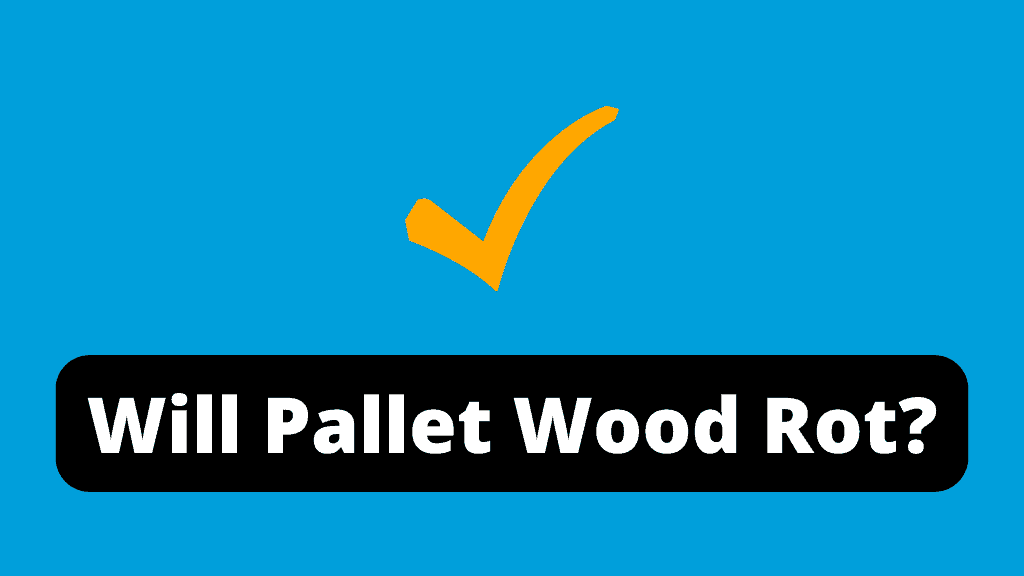If you’re new to woodworking, or even if you are a seasoned craftsperson interested in trying out something new, then you may be wondering whether pallet wood is a good choice for your projects.
There are a lot of things to consider before getting started – and one of the most important is what types of materials will work best in your situation. If you’re planning to use pallet wood in a DIY project, it’s important to know if the material will rot over time and is safe for handling. You might also want to consider using a different material altogether.
In this blog post, we’ll explore these issues and look at some benefits as well as potential drawbacks. We’ll also break down some ways that you can use these materials safely so that you can feel confident about using them in your projects!
So, will pallet wood rot?
Yes, pallet wood will eventually rot. You can prolong the life of your creations by reducing exposure to moisture and using a sealer such as linseed oil, tung oil, hemp oil, polyurethane, varnish, or a similar substance.
For more information, please consult the sections below:
What is wood rot?
Wood rot is a natural process caused by fungi that live in the wood and need moisture to grow. They multiply best when conditions are wet, which can happen at any time but is more likely during the warmer months when humidity levels are higher.
Wood rot can weaken structural beams, cause floors to become uneven, and create an overall unsightly appearance in a home or office space. Early detection of wood rot and taking steps to remediate the issue are important in order to prevent extensive damage from occurring.
If wood rot is not remediated, it will continue to weaken the structure of your project The overall appearance of the home or office space will also suffer.
There are several types of wood rot:
Brown rot
This is caused by a fungus that attacks cellulose and hemicellulose in the wood. The decayed wood often breaks along lines that are perpendicular to the grain, As a result, the pieces are often square or cubical. The term for this is cubical fracture.
White rot
This type of fungus can break down cellulose, hemicellulose, and also lignin. This type of rot is often spongy to the touch and can cause serious structural damage.
Soft Rot
This is a form of rot that doesn’t really get talked about much. It’s the least common form of rot.
If you want to prevent wood rot in your pallet wood projects, then there are several things you can do. The first thing is to make sure that there is proper ventilation in your workshop. You can do this by using fans and opening windows when possible. This will reduce moisture in the air. Another thing you can do is to use a dehumidifier in your workshop. This will also help keep moisture down, which will reduce the chances of wood rot. Your pallets should also be stored somewhere where they’re not going to get wet or exposed to rain or snow.
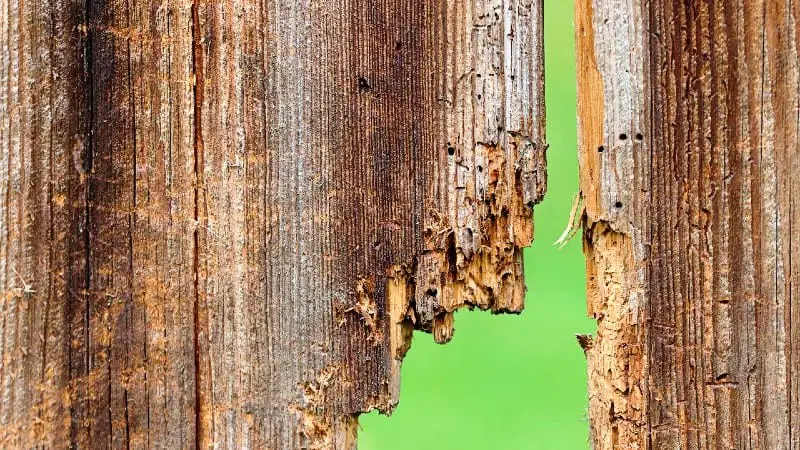
Why does it matter if pallet wood will rot?
It’s important to know the potential implications of using pallet wood so that you can make an informed decision about whether or not it’s the right material for your project. If you’re ok with the fact that it may only last a few years, then go ahead and use it! However, if you want your project to last longer, you’ll need to take some extra steps (which are detailed below) to protect the wood from moisture.
How do you stop wood from rotting?
Wood rot is a common problem for DIYers, and it’s easy to see why. You’re doing something you love – for many of us, that’s woodworking. And when you’re just starting out, it seems like the only way to get better at it is to practice as much as possible.
But what if your wood is rotting? That can throw a wrench into your plans! Fortunately, there are some steps you can take to avoid this issue:
1) Use the right kind of wood. While all wood will eventually rot, there are some types that are more resistant than others – and if you use them, they’ll last longer. Some of the best types are cedar, redwood, cypress, and teak. Many pallets are made from oak and pine.
2) Avoid damp conditions. If you’re using pallet wood outside, try to avoid letting it get wet.
3) Seal pallet wood. Coat the wood with linseed oil or another sealer to help prevent water from getting inside and rotting the wood. Other sealers are Thompson’s water seal, polyurethane, shellac, varnish, and many more!
4) Treat with borate – Borate wood treatments are effective at preventing mold and rot, so just mix some powder (found in hardware stores) together with water. Then apply it to the pallet’s surface using a brush or spray bottle
What type of wood is pallet wood?
If you are new to woodworking, or just want to make sure you’re using materials that will last, it’s important to know what types of wood are used in pallets. The most common types of wood for pallets made in the United States are pine and oak.
Pine is a softwood – It’s easier to work with than hardwoods like oak but also more prone to rot if left outside.
Oak, on the other hand, is a hardwood – It tends to be more resistant to rot than pine. You shouldn’t have to worry about oak furniture breaking down as quickly over time because it’s one of the most durable woods available.
Both hardwoods and softwoods have their own unique properties – it’s important to choose the right type of wood for your project!

Does pallet wood need to be treated?
Pallet wood is one of the most popular materials for DIYers and those new to woodworking because it can be used for almost anything.
However, you should know that there are two types of pallets:
1) Domestic pallets – These are ones used for the transfer of goods within the United States. These pallets don’t need to be treated. However, many pallet manufacturers choose to kiln-dry the wood in order to reduce the moisture content and make it less likely for the boards to warp.
2) International pallets – These pallets are used to transfer goods between countries. They must be treated to prevent the spread of pests and insects from one country’s agricultural system into another’s.
How do you tell if a pallet is treated?
As a DIYer or a new woodworker, you may have come across pallets that you want to use for your projects. However, you might be wondering how the wood was treated.
To find out, look for stamps on pallets. These stamps will give information about the country that produced them and what sort of treatment they received to reduce the transmission of pests from one area to another.
These stamps are required to be put on international pallets by IPSM 15, a measure taken by the IPPC (International Plant Protection Convention), a treaty signed by many countries around the world.
1) If the stamp says MB, it means that the pallet was treated with Methyl Bromide, This is a toxic fumigant that’s used in agriculture – and also on some pallets.
The reason this is important is that Methyl Bromide has been known to cause cancer in humans. It can also cause other health concerns like headaches, dizziness, and nausea. Needless to say, pallets that have been treated with Methyl Bromide should not be used in DIY projects!
2) If the stamp says HT (Heat Treatment), then the pallet was heated to at least 56 degrees centigrade for at least 30 minutes. This kills most pests and also increases the resistance of the wood to rot.
3) If the pallet does not have a stamp, it was probably used for transport within the United States. While you do not know what treatment it had, you can probably assume that it was not fumigated with the hazardous pesticide Methyl Bromide, since this pesticide is no longer used in the United States except under very specific circumstances. However, you should be aware that pallets are sometimes used to transport chemicals. Check for any remaining residue of these products before using the wood.
This matters because it is important to know where your pallet wood has come from and what treatments it may have undergone. This is especially important if you are going to be using the wood for something that will come into contact with food or skin, like a cutting board. The implications of using treated or chemical-laden pallet wood can be serious, so it is always best to err on the side of caution.
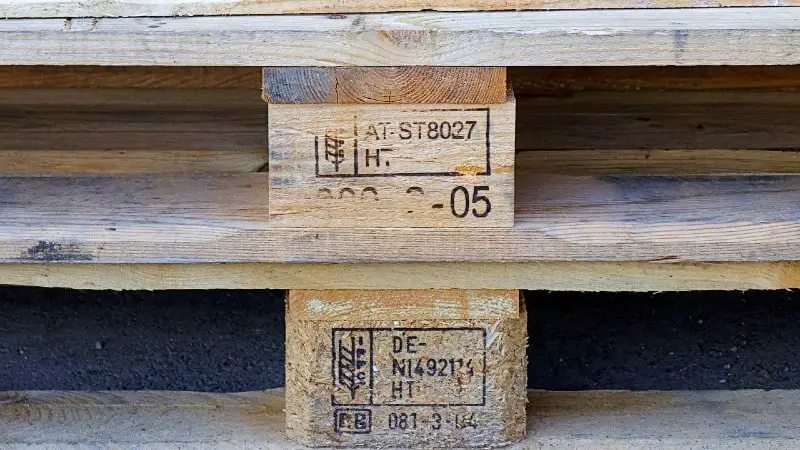
Can pallet wood get wet?
Yes, it can!
Moisture can damage pallet wood in many ways. First, it can promote the growth of mold and fungus. Moisture will also lead to the warping of wood boards.
Here are some common ways that pallet wood can get wet:
From rainwater – The moisture from the rain will saturate your pallet wood and cause it to rot. If any part of your project is exposed to rainwater or other moisture – even if only for a short period of time – you run the risk of mold growth on those pieces.
From tears – If you’re not careful, you can get yourself into a very sticky situation. If you drop your pallet wood on the ground in a puddle of tears, then it will soak up all of those salty droplets and begin to break down. (Just Kidding!).
The area is wet – You’re working in a wet area (like a basement).
The humidity is high – You use pallet wood in a “rainforest-like” environment where there’s lots of humidity
When you obtain pallets, it’s best to check them for any signs of damage or rot. I wrote another article about mold on pallets.
Can you waterproof pallet wood?
You can add some degree of water resistance to pallets by coating the wood with a sealer. Sealers help prevent moisture from getting into the wood and causing rot. You can use a sealer on pallet wood that you’ll be using outside – for example, if you plan to build a DIY pallet patio. A few coats of Marine Spar Varnish will help to waterproof the wood and make it last longer. However, sealing the wood won’t prevent water from getting into the wood; it only slows down moisture absorption by making it more difficult for water to penetrate the wood.
You can use these common sealers:
Linseed oil – This is an oil that’s derived from flax seeds. When applied to wood, it soaks in and dries to form a hard, protective coating. You can find this at hardware stores.
Tung oil – This is another oil that forms a similar protective coating. It’s extracted from the nuts of tung trees and dries to form a hard finish. You can find this at some hardware stores or online.
Minwax Polycrylic Protective Finish – This is a water-based sealer that goes on clear and dries quickly. It’s available at most home improvement stores.
Marine spar varnish – This is a clear varnish that’s made to protect wood in outdoor environments. It’s available at most home improvement stores.
There are a number of different options for finishes that will protect your wood from water damage. Choose the one that best fits your needs and budget.
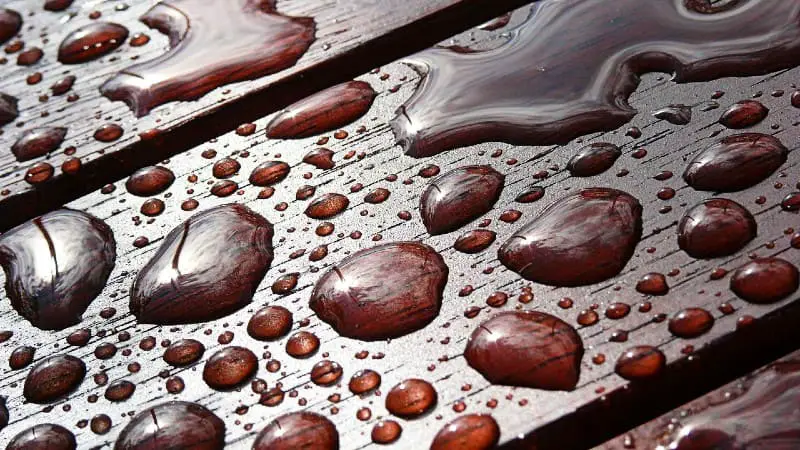
Will pallet wood last outside?
Pallet wood is a common material used by woodworkers, so you’re likely to run into it. It’s also popular among DIYers and homeowners looking to build furniture or other projects on a budget.
The first thing you need to understand is that pallet wood will eventually rot if it’s not treated properly. The type of wood can be an important factor in how long it takes for this process to begin, but even the most durable species won’t last forever outdoors without some intervention.
The exact rate at which your pallet will deteriorate depends largely on its exposure to water and moisture, so if you plan on using the boards directly outdoors (for example as decking), they’ll likely suffer from rot faster than if they’re kept indoors or under shelter from direct rain exposure.
Is pallet wood safe for your garden?
Yes, it can be!
Pallet wood is a great resource for DIYers and those new to woodworking. It’s easy to find and cheap, but there are still some things you should know before using it in your garden.
First, make sure that the pallet is free of chemicals. Many pallets are treated with pesticides or other chemicals to keep insects out of them during transit. I wrote another article about the safety of pallets.
If you’re using pallet wood in a garden, it’s important to seal the wood first—especially if you’re using it outdoors. You don’t want the wood to rot in the rain or snow, which can happen if the wood is not sealed properly. However, you need to make sure that you are using an Eco-friendly sealer that is totally safe for garden use. This is even more important if the garden is to be used to grow a food product. For example, Raw tung oil is a natural product and, by itself, is safe for garden use. However, it is very slow drying. As a result, most Tung oil products available in the hardware store contain a thinner. The thinner, by itself, can be toxic. Products like that are not safe to use in a garden. This article has more information about linseed oil, tung oil, and toxic additives.
Another option to reduce rotting is some other wood such as Redwood for your garden. This is highly resistant to water in its natural form and is a popular material for garden boxes.
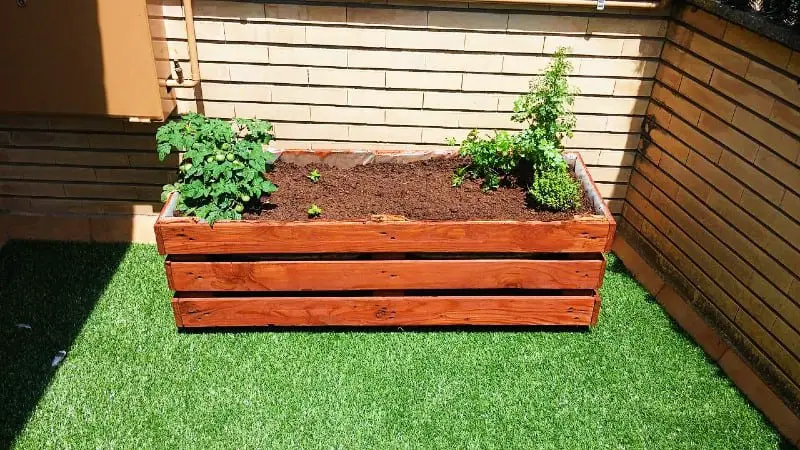
Conclusion – Will Pallet Wood Rot?
We hope you found this blog post useful, and we want to give you a quick rundown of what we covered:
You can use pallet wood for DIY projects, but it’s important to know that it can rot if you don’t take proper care of it.
You should protect your pallet wood from moisture by storing it in a dry area and sealing it with a sealant or varnish.
If you’re planning to use pallet wood in the garden, you should consider using an environmentally friendly sealant to reduce wood rot.
You can also use pallet wood for other DIY projects, and you should always check the condition of the wood before using it
There are many different types of pallet wood, including hardwood and softwood – each with its own benefits and drawbacks. Hardwood is more robust and resistant to rot. However, it is heavier and harder to work with.
Did you enjoy reading this article? If so, you might be interested in my Pinterest profile. It contains pins about Woodworking, DIY & Crafts, Tools, Projects, Hardware, and many, many other things!

